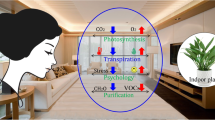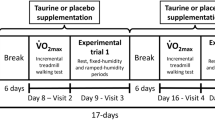Abstract
This study determined whether a torso-vest forced ambient air body ventilation system (BVS) reduced physiological strain during exercise-heat stress. Seven heat-acclimated volunteers attempted nine, 2-h treadmill walks at 200 W m−2 in three environments, −40°C, 20% rh (HD), 35°C, 75% rh (HW), and 30°C, 50% rh, (WW) wearing the Army Combat Uniform, interceptor body armor (IBA) and Kevlar helmet. Three trials in each environment were BVS turned on (BVSOn), BVS turned off (BVSOff), and no BVS (IBA). In HD, BVSOn significantly lowered core temperature (T re), heart rate (HR), mean skin temperature (T sk), mean torso skin temperature (T torso), thermal sensation (TS), heat storage (S), and physiological strain index (PSI), versus BVSOff and IBA (P < 0.05). For HW (n = 6), analyses were possible only through 60 min. Exercise tolerance time (min) during HW was significantly longer for BVSOn (116 ± 10 min) versus BVSOff (95 ± 22 min) and IBA (96 ± 18 min) (P < 0.05). During HW, BVSOn lowered HR at 60 min versus IBA, T sk from 30 to 60 min versus BVSOff and IBA, and PSI from 45 to 60 min versus BVSOff and at 60 min versus IBA (P < 0.05). BVSOn changes in T re and HR were lower in HD and HW. During WW, BVSOn significantly lowered HR, T sk, and T torso versus BVSOff and IBA (P < 0.05) during late exercise. Sweating rates were significantly lower for BVSOn versus BVSOff and IBA in both HD and WW (P < 0.05), but not HW. These results indicate that BVSOn reduces physiological strain in all three environments by a similar amount; however, in hot-dry conditions the BVSOff increases physiological strain.




Similar content being viewed by others
References
Berglund LG (1998) Comfort and Humidity. ASHRAE J 35–41
Borg G (1970) Perceived exertion as an indicator of somatic stress. Scand J Rehabil Med 2:92–98
Cadarette BS, Blanchard L, Staab JE, Kolka MA, Sawka MN (2001) Heat stress while wearing body armor. Technical Report T01-9. US Army Research Institute of Environmental Medicine, Natick
Cadarette BS, Matthew WT, Sawka MN (2005) WBGT index temperature adjustments for work/rest cycles when wearing NBC protective clothing or body armor. Technical Report TN05-04. US Army Research Institute of Environmental Medicine, Natick
Cadarette BS, Santee WR, Robinson SB, Sawka MN (2007) Reflective inserts to reduce heat strain in body armor: tests with and without irradiance. Aviat Space Environ Med 78(8):809–813
Chen YT, Constable SH, Bomalaski SH (1997) A lightweight ambient air-cooling unit for use in hazardous environments. Am Ind Hyg Assoc J 58:10–14
Cheuvront SN, Goodman DA, Kenefick RW, Montain SJ, Sawka MN (2008) Impact of a protective vest and spacer garment on exercise-heat strain. Eur J Applied Physiol 102:577–583
Consolazio FC, Johnson RE, and Pecora LJ (1963) The computation of metabolic balances. In: Physiological measurements of metabolic functions in man. McGraw-Hill, New York
Gagge AP, Gonzalez RR (1996) Mechanisms of heat exchange: biophysics and physiology. In: Fregly MJ, Blatteis CM (eds) Handbook of physiology: environmental physiology. American Physiological Society, Bethesda
Gagge AP, Stolwijk JAJ, Hardy JD (1967) Comfort and thermal sensation and associated physiological responses at various ambient temperatures. Environ Res 1:1–20
Gonzalez RR (1988) Biophysics of heat transfer and clothing considerations. In: Pandolf KB, Sawka MN, Gonzalez RR (eds) Human performance physiology and environmental medicine at terrestrial extremes. Benchmark, Indianapolis
McCullough EA, Eckels S, Harms C (2006) A comprehensive evaluation of personal cooling systems (PCS) for Soldiers. Technical Report 3-06 (Pt I). Institute for Environmental Research, Kansas State University, Manhattan
Mitchell JW, Nadel ER, Stolwijk JAJ (1972) Respiratory weight losses during exercise. J Appl Physiol 32:474–476
Moran DS, Shitzer A, Pandolf KB (1998) A physiological strain index to evaluate heat stress. Am J Physiol 275:R129–R134
Muza SR, Pimental NA, Cosimini HM, Sawka MN (1988) Portable, ambient air microclimate cooling in simulated desert and tropic conditions. Aviat Space Environ Med 59:553–558
Pandolf KB, Gonzalez JA, Sawka MN et al (1995) Tri-service perspectives on microclimate cooling of protective clothing in the heat. Technical Report T95-10. US Army Research Institute of Environmental Medicine, Natick
Ramanathan NL (1964) A new weighting system for mean surface temperature of the human body. J Appl Physiol 19:531–533
Rowell LB, Marx HJ, Bruce RA et al (1966) Reductions in cardiac output, central blood volume, and stroke volume with thermal stress in normal men during exercise. J Clin Invest 45(11):1801–1816
Sawka MN, Young AJ (2006) Physiological systems and their responses to conditions of heat and cold. In: Tipton CM (ed) ACSM’s advanced exercise physiology. Lippincott Williams and Wilkins, Philadelphia
US Army (2003) Heat stress control and heat casualty management. Department of army and air force technical bulletin, TBMED507/AFPAM 48-152(1), Washington D.C
Vallerand AL, Savourey G, Hanniquet A, Bittel JHM (1992) How should body heat storage be determined in humans: by thermometry or calorimetry? Eur J Appl Physiol 65:286–294
Yarger WE, Litt BD, Goldman RF (1969) Body armor in a hot humid environment. II. Studies in heat acclimatized men. Res Rep US Nav Med Field Res Lab 19:1–42
Acknowledgments
The authors wish to thank the USARIEM staff who assisted on this project. The authors would also like to thank the seven soldiers who volunteered their time to take part in this study. The view, opinions, and/or findings contained in this report are those of the authors and should not be construed as an official Department of the Army position, or decision, unless so designated by other official documentation. Approved for public release, distribution unlimited.
Author information
Authors and Affiliations
Corresponding author
Rights and permissions
About this article
Cite this article
Chinevere, T.D., Cadarette, B.S., Goodman, D.A. et al. Efficacy of body ventilation system for reducing strain in warm and hot climates. Eur J Appl Physiol 103, 307–314 (2008). https://doi.org/10.1007/s00421-008-0707-9
Accepted:
Published:
Issue Date:
DOI: https://doi.org/10.1007/s00421-008-0707-9




